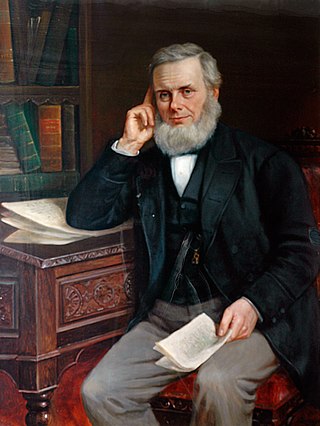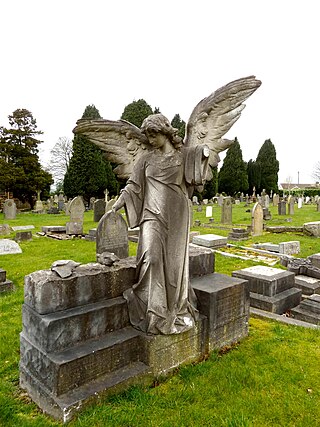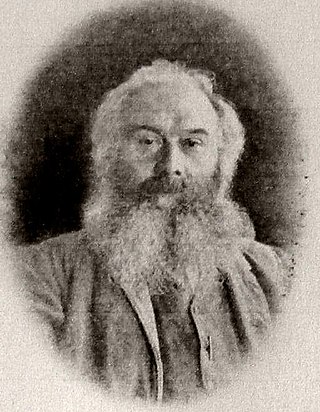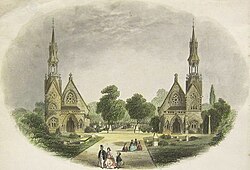
Thomas Henry Sage VC was a British Army soldier from Tiverton, Devon, and a recipient of the Victoria Cross (VC), the highest military decoration awarded for valor “in the face of the enemy” to members of the British and Commonwealth forces.

William Grainge was an English antiquarian and poet, and a historian of Yorkshire. He was born into a farming family in Dishforth and grew up on Castiles Farm near Kirkby Malzeard in the North Riding of Yorkshire, where he studied the archaeological site beneath the farm buildings, now known as Cast Hills settlement. Although he left school at age 12, he educated himself well enough to become a clerk to a solicitors' firm in Boroughbridge. He later established a bookshop in Harrogate and published numerous books on local history and topography, besides publishing a number of anonymous poems and discourses about local natural history.

Lizzie Ida Grace Willis was a notable New Zealand civilian and military nurse, hospital inspector, matron, army nursing administrator. She was part of the New Zealand Army Nursing Service Corps and the Samoan Expeditionary Forces in 1914.

West Park United Reformed Church is located in the West Park area of Harrogate, England, and is a Grade II listed building. It was designed in Nonconformist Gothic style as West Park Congregational Church by Lockwood & Mawson and completed in 1862 for around £5,000. Along with Belvedere Mansion across the road, it was intended as part of the prestigious entrance to the Victoria Park development. For the Congregationalists it was meant to house an increasing congregation of visitors brought to the spa town by the recently-built railways. It became a United Reformed church in 1972.

Harlow Hill Cemetery on Otley Road, Harrogate, North Yorkshire, England, is a local authority cemetery established on land donated by Henry Lascelles, 4th Earl of Harewood in 1869, and consecrated on 3 October 1871 by the Bishop of Ripon. It features the Gothic Revival Church of All Saints, designed by Isaac Thomas Shutt and Alfred Hill Thompson. It has individual memorials to casualties of World Wars I and II, and other graves include those of actor Michael Rennie and Catherine Gurney, an activist in the Temperance movement in the United Kingdom.

John Peele Clapham, from Leeds, West Riding of Yorkshire, was a justice of the peace for the West Riding of Yorkshire, and treasurer for the county courts of Yorkshire.

John Farrah, F.L.S., F.R.Met.S was a British grocer, confectioner, biologist and meteorologist from Harrogate, North Riding of Yorkshire, England. In the late 19th century he developed the business strategy for Farrah's toffee shop which he inherited from his family in Harrogate. He was made a fellow of the Meteorological Society in 1894. He was president of the botanical section of the Yorkshire Naturalists' Union, working with Thomas Sheppard, George Edward Massee, William Eagle Clarke and Charles Crossland, and in 1903 discovered the mycological species Entoloma farrahi, which was named after him, although there has been some question as to its identity since then. He was a close friend of Harrogate historian William Grainge and for some years they were "constant companions", supporting each other in their work. The American mycologist George Francis Atkinson described him as a "great Yorkshire character". Farrah married three times, and had three children.

Thomas Holroyd was an English portrait and landscape painter working in Harrogate, North Riding of Yorkshire, England. Before his marriage he undertook painting tours to the United States, Canada, Europe, Egypt, Russia and the Holy Land. Returning to Harrogate, he painted portraits of the local worthies there. He shared responsibility for the successful photography business T & J Holroyd with his brother James, and continued to run the business after his brother died. Holroyd was a founding member of Harrogate Liberal Club.

William John Seward Webber was an English sculptor who created civic statuary, and busts of national heroes and local worthies, in marble. He sculpted the statue of Queen Victoria for the Jubilee Monument in Harrogate, North Riding of Yorkshire, England in 1887. An early success was his Warrior and Wounded Youth group of 1878, executed while he was still a student. His busts include portraits of the Duke of Clarence, John Charles Dollman, Henry Phillpotts, John Bowring, John Ruskin, Richard Jefferies, Alfred, Lord Tennyson, Charles Darwin, Walter Scott, Thomas Carlyle, Robert Burns and Thomas Holroyd.

H. E. and A. Bown was an architectural practice in Harrogate, North Riding of Yorkshire, England, in the 19th and early 20th centuries. Its two partners were Henry Edwin Bown who started the business and died at the age of 36, and his brother Arthur Bown, who carried on the business until he retired in 1911.

Robert Ackrill was an English journalist, newspaper proprietor, founder of newspapers, printer and writer, working for most of his career in Harrogate, England. During the 19th century he owned six newspapers in the North and West Ridings of Yorkshire, via his company Ackrill Newspapers, having founded three of them. Ackrill's descendants and relatives continued to run or be involved with Ackrill newspapers for at least a hundred years, the final incarnation of the company under that name being dissolved in 2020.

George Dawson was an English builder, property developer and alderman. The son of a village labourer, he was a self-made man who started as a cooper, became a rich entrepreneur and built himself a mansion.

Richard Ellis was an English builder, property developer, alderman, mayor, and a public benefactor to his town. The son of a blacksmith, he was a self-made man who started as a joiner and became a rich developer who joined High and Low Harrogate into a single town, helped obtain a Charter of Corporation, and promoted the erection of civic buildings appropriate for a spa town. Thus he became known as the Bismarck of Harrogate, his achievement in joining two villages to create a single town having been wittily compared in the 19th century with Bismarck's unification of Germany.
Daniel Schwarz was a German trumpeter, and the band leader of the travelling Schwarz Band from Hinzweiler, Germany. His home town had a strong musical culture, so although he was a smallholder in Germany, in the summers he would work in the manner of the West Palatine Wandermusikanten, who would travel as musical entertainers throughout Europe in the 19th and early 20th centuries. Schwarz's venues in England were the Raikes Hall Gardens at Blackpool where he was bandmaster and also in the Oddfellows' Hall, Pateley Bridge and in Harrogate, North Riding of Yorkshire.

David Simpson was an English builder, politician, property developer and contractor who was four times mayor of Harrogate, and three times deputy mayor. He developed the whole of the Duchy Estate, a major residential quarter for the rich, more than doubling the rateable value of the town in the first quarter of the 20th century. He was a member of Harrogate Borough Council for 34 years, making him the "father" of the council by the end of his career there. He was a justice of the peace and the first honorary Freeman of the Borough of Harrogate. He was president of the Bilton Ward Conservatives, a member of the Knaresborough Board of Guardians and an alderman of West Riding County Council. He built himself a large, castellated mansion called Oakdale, in 1903, besides the even larger Grand Hotel in Harrogate in the same year..
John Turner was an English draper, landlord, and moneylender, whose perceived behaviour led to his reputation as a miser.

Laura Sobey Veale, known as Dr Laura, was an English general practitioner, gynaecologist, and obstetrician. She was the first Yorkshire-born woman to become a doctor. She was refused entry to Leeds School of Medicine, even though the Leeds Mercury published letters of complaint about her treatment. With encouragement from Elizabeth Garrett Anderson and support from a local boys' school she was finally accepted at the London Royal Free Hospital School of Medicine for Women, and qualified with a Bachelor of Medicine (MB) degree at the age of 37.
Richard Durnford Jr. was a British civil servant. He served as Secretary to the Charity Commissioners of England and Wales from 1891 to 1908.

Clifton House School was a private boys' preparatory school which operated in Harrogate, North Riding of Yorkshire, England, between 1898 and 1968. It was founded in Clifton House in Queens Parade just as George Mearns Savery's Harrogate College for boys in Bilton was closing, thus acquiring the name of Clifton College, then Clifton House School. It kept that name until its last years when it became Clifton House Preparatory School. In 1909 the school established the first scout pack in Harrogate.

Harold Styan was an English gymnast and physical culturist in the music halls in his youth, a physical training instructor and drill sergeant in the First World War, and a sports teacher and youth worker in Harrogate, Yorkshire, for the rest of his life.






























